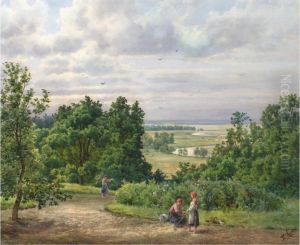Pjotr Klodt Paintings
Pyotr Karlovich Klodt (also spelled as Pjotr Klodt or Peter Clodt von Jürgensburg), born in 1805 in St. Petersburg, Russia, was a prominent Russian sculptor and member of the famous Klodt family, known for its significant contributions to Russian art and culture. He was a baron by birth and closely associated with the imperial court, reflecting the era's social and artistic norms through his works. Klodt's artistic journey was deeply influenced by his time at the Imperial Academy of Arts in Saint Petersburg, where he honed his craft under the tutelage of renowned artists. His education played a crucial role in shaping his classical style, which later evolved to incorporate elements of Romanticism.
Klodt's major contributions to Russian sculpture include his monumental works and his role in the development of equestrian statues, a genre in which he excelled. Among his most famous works are the equestrian statues of the Anichkov Bridge in Saint Petersburg, depicting the taming of wild horses. These sculptures not only showcase his mastery of form and movement but also reflect the romantic spirit of the era, capturing the dynamic interplay between man and nature. Klodt's work on the Anichkov Bridge has become iconic, symbolizing the artistic and cultural achievements of 19th-century Russia.
Beyond his achievements in sculpture, Klodt was an influential figure in Russian cultural circles, contributing to the development of the arts through his participation in various artistic societies and his close relationships with other prominent artists and intellectuals of the time. His legacy is preserved not only in his sculptures but also in the respect and recognition he garnered among his contemporaries and in the annals of Russian art history.
Klodt's career was emblematic of the broader trends in Russian art during his lifetime, as the country grappled with its place between East and West and sought to define its own artistic identity. Through his works, Klodt captured the spirit of his age, blending classical influences with a uniquely Russian sensibility. He passed away in 1867, leaving behind a body of work that continues to be celebrated for its beauty, emotional depth, and technical mastery. Klodt's contributions to the field of sculpture and to Russian culture at large have ensured his place as a key figure in the history of art.
